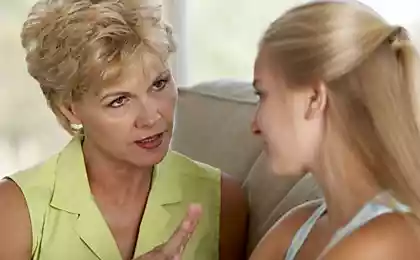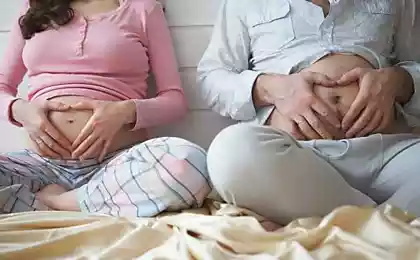469
How was giving birth in the old days
Now a lot of talk about how in the old days was the way of the life of a pregnant woman and woman with recently born. There is a perception that pregnant and gave birth like cheese in butter rolls around. Especially a sin by inventing all sorts of fables of the so-called supporters of natural childbirth, long breastfeeding and co sleeping. And how things really are?
Alas, nothing like that. About pregnancy women, as a rule, learned rather late, because the only reliable sign that a woman is pregnant, there was a clear movement of the fetus. That is, when the woman stopped "shirt", it is assumed that "tatarella", but talked about established pregnancy only after the fetus has begun to move.
Eleven million eighty thousand fifty seven
That supposedly pregnant women in Russia were treated with reverence, is a myth. Pregnancy is often perceived as a hindrance and always as something quite ordinary: think, suffered bad business not artful. Pregnancy was not perceived as a sacrament, it was a natural process, which cost no more attention than a light cold. In olden days it was believed that miscarriage in women can only be for two reasons: sin or "made", not from hard work, therefore, no exceptions pregnant is not received, continued working hard, fulfilling all her duties around the house. As historians, often a woman went to give birth, leaving the Laundry in a trough or nedomoganie dough. As for birth in the field, which so love to talk to admirers of the natural way of life, it is, of course, the illusion that women put down the hammer, gave birth, and immediately jumped to his feet to continue the job "and nothing", and everything, they say, was healthy and strong.
Despite the fact that such births were not uncommon, no sane woman did not want to resolve in the field. Yes, there have been cases of childbirth right into a haystack, but it was not the norm. If the beginning of Rodin caught a woman in a field, she was trying to get home so that the birth took place in more suitable conditions. Well, if you met a cart — it can drive you to the house, however, it happened that the woman shaken up in the cart, right in her and gave birth. In other cases, a woman in labor get to the house on foot. Field gave birth to those he could reach the house. Happened birth and on the banks of the river during the rinse of underwear, it happened that women managed to give birth during the "shopping" — at the fair.
The baby was delivered by a midwife, she's the midwife. This is a woman who has mastered the art of midwifery, and providing maternal care. The midwife controlled the whole birth process, which could last several days, if necessary, took steps to remedy the situation of the fetus to expedite delivery, swaddled baby-born — midwife, from what is actually happening the name of these ancient midwives — midwives. By the way, in mandatory post-partum recovery was povivaye women — grandmother of day two or three led her to the bath, there steamed the woman "ruled the stomach" and then for a few hours, and if necessary, for a few days tightly pulled fabric bandages — it served as a prevention of hernias and uterine prolapse. But swaddling is not always saved from this disaster.
How was the actual birth?
Realizing that the woman it's time to give birth, mother in law, mother or another woman in the family has sent someone or went for the midwife. Again, out of fear that evil spirits might harm the mother, was in a roundabout way and his grandmother's name was not direct, and figuratively: "Gone would you take our cow to see, and then promised, not going." The services of midwives was estimated at about ten cents, one bread, and one cake. If the mother-in-law was stingy, and the price to negotiate failed, and the woman had to give birth without more or less qualified assistance.
Fourteen million four hundred twenty seven thousand four hundred forty one
"Reaper", K. Makovsky
The new mother usually took in the heated bath is the cleanest room in the courtyard. One poverty there was a bath, gave birth in a hut. There, in the society of a midwife, the mother experienced during labor. There are many techniques to accelerate delivery. The fight, the woman usually endured standing: it is placed in the doorway and forced to hang on a bar or on the reins, thrown over the rail. If the process is delayed, then the woman could three times to circle around the table, forced to blow into the bottle, tilting the Board (put on a wide Board and abruptly move from the position head-down position down down), get up the ladder to the barn and back again, suddenly drenched with bucket of ice water, or solicited other women sharply to break into the bath, shouting "Burn! Fire!"banging it in this rolling pins in the trough.
If things were really bad, then sent to the priest to serve a prayer service to open the Royal gates — the last was considered particularly effective. About any C-section for peasant women could not be considered. If after childbirth bad departed the placenta, the woman is shoved in her mouth fingers or her hair, it was considered that the resulting retching and promotes the separation of the placenta. It is not surprising that in such a obstetrics in Russia before the revolution, every seventh births ended with the death of a woman. So talk about that in the old days gave birth easily, also no more than fiction.
Men are never present at birth. The exception was if it was required to do some manipulation of the woman in labor, for example, to raise it to the Board. Only then could call for reinforcements of men, which after the necessary assistance immediately left. No one could not imagine such folly, as joint childbirth.
Newborn umbilical cord was tied with a linen thread and cut, in some areas it was customary for the midwife cut his umbilical cord. To invite to childbirth of the doctor could only afford urban residents on the condition that they were solvent. About the luxury of birthing in the maternity ward, could not be considered. The catch is that the first maternity hospital appeared in Russia in Moscow in 1764, and was intended not for the comfort of expectant mothers and newborns, and to reduce the number of "street" delivery in walked the women who their babies are then usually thrown down the drain or in a landfill. To deliver in that hospital was a disgrace for respectable women, so in fact until the early twentieth century gave birth exclusively at home.
The woman was allowed to lie three days after a difficult birth for up to nine days, then raised it, and the same midwife her "shopping around". However, this was only possible in large families where there was someone to replace the woman. In rich families, the mother was released from work for the entire postpartum period to six weeks. If the family lived apart, their home, without relatives, the mother was forced to get up almost an hour after birth and begin the usual chores.
If the birth was in the summer, then three days later, within a week the woman was already in the field: it was thought that the work contributes to rapid recovery. Because of this, many women gained weight postpartum complications such as hernia, bleeding, uterine prolapse. The only assistance they received came from odnoselchanok: those for a week or two went to congratulate the postpartum with a newborn and brought with them a ready-made meal allowing though as-that to facilitate her work on the farm.
Contrary to popular belief, the baby did not put to the breast immediately after birth. Colostrum is usually decanted — it was considered "evil", "witches ' milk", can bring the baby sickness. Was breast-fed if possible, it allowed the employment of the mother. Often the woman was asked to feed her baby cousin or neighbor who was not so busy on the farm.
If conditions allowed, the women tried to breastfeed as long as possible, "while the child is not was ashamed," but not for the sake of feeding, and in order not to get pregnant, according to surveys of peasant women in the nineteenth century, 80% of women at least once a day nursing children, critical days absent for three or four, and sometimes seven years. At the time breastfeeding was a reliable method of birth control.
Of course, could not be and speeches about a culture of sexual relations. According to historians of those times, when, how and how many is always decided man. In this issue again dominated the consumer attitude towards women. The men climbed to satisfy my lust, completely disregarding the health and status of women: no menses, pregnancy, recent childbirth or fatigue was not a reason to "wait". He wants — she has to. In this scenario, a marital debt is often turned into the usual brute force. And anything surprising was not that often a woman, barely after giving birth, a month-another would be "pregnant," and all repeated around the circle... posted
Author: Lily Malakhov
P. S. And remember, just changing your mind — together we change the world! © Join us at Facebook , Vkontakte, Odnoklassniki
Source: www.matrony.ru/kak-rozhali-v-starinu/
Alas, nothing like that. About pregnancy women, as a rule, learned rather late, because the only reliable sign that a woman is pregnant, there was a clear movement of the fetus. That is, when the woman stopped "shirt", it is assumed that "tatarella", but talked about established pregnancy only after the fetus has begun to move.
Eleven million eighty thousand fifty seven
That supposedly pregnant women in Russia were treated with reverence, is a myth. Pregnancy is often perceived as a hindrance and always as something quite ordinary: think, suffered bad business not artful. Pregnancy was not perceived as a sacrament, it was a natural process, which cost no more attention than a light cold. In olden days it was believed that miscarriage in women can only be for two reasons: sin or "made", not from hard work, therefore, no exceptions pregnant is not received, continued working hard, fulfilling all her duties around the house. As historians, often a woman went to give birth, leaving the Laundry in a trough or nedomoganie dough. As for birth in the field, which so love to talk to admirers of the natural way of life, it is, of course, the illusion that women put down the hammer, gave birth, and immediately jumped to his feet to continue the job "and nothing", and everything, they say, was healthy and strong.
Despite the fact that such births were not uncommon, no sane woman did not want to resolve in the field. Yes, there have been cases of childbirth right into a haystack, but it was not the norm. If the beginning of Rodin caught a woman in a field, she was trying to get home so that the birth took place in more suitable conditions. Well, if you met a cart — it can drive you to the house, however, it happened that the woman shaken up in the cart, right in her and gave birth. In other cases, a woman in labor get to the house on foot. Field gave birth to those he could reach the house. Happened birth and on the banks of the river during the rinse of underwear, it happened that women managed to give birth during the "shopping" — at the fair.
The baby was delivered by a midwife, she's the midwife. This is a woman who has mastered the art of midwifery, and providing maternal care. The midwife controlled the whole birth process, which could last several days, if necessary, took steps to remedy the situation of the fetus to expedite delivery, swaddled baby-born — midwife, from what is actually happening the name of these ancient midwives — midwives. By the way, in mandatory post-partum recovery was povivaye women — grandmother of day two or three led her to the bath, there steamed the woman "ruled the stomach" and then for a few hours, and if necessary, for a few days tightly pulled fabric bandages — it served as a prevention of hernias and uterine prolapse. But swaddling is not always saved from this disaster.
How was the actual birth?
Realizing that the woman it's time to give birth, mother in law, mother or another woman in the family has sent someone or went for the midwife. Again, out of fear that evil spirits might harm the mother, was in a roundabout way and his grandmother's name was not direct, and figuratively: "Gone would you take our cow to see, and then promised, not going." The services of midwives was estimated at about ten cents, one bread, and one cake. If the mother-in-law was stingy, and the price to negotiate failed, and the woman had to give birth without more or less qualified assistance.
Fourteen million four hundred twenty seven thousand four hundred forty one
"Reaper", K. Makovsky
The new mother usually took in the heated bath is the cleanest room in the courtyard. One poverty there was a bath, gave birth in a hut. There, in the society of a midwife, the mother experienced during labor. There are many techniques to accelerate delivery. The fight, the woman usually endured standing: it is placed in the doorway and forced to hang on a bar or on the reins, thrown over the rail. If the process is delayed, then the woman could three times to circle around the table, forced to blow into the bottle, tilting the Board (put on a wide Board and abruptly move from the position head-down position down down), get up the ladder to the barn and back again, suddenly drenched with bucket of ice water, or solicited other women sharply to break into the bath, shouting "Burn! Fire!"banging it in this rolling pins in the trough.
If things were really bad, then sent to the priest to serve a prayer service to open the Royal gates — the last was considered particularly effective. About any C-section for peasant women could not be considered. If after childbirth bad departed the placenta, the woman is shoved in her mouth fingers or her hair, it was considered that the resulting retching and promotes the separation of the placenta. It is not surprising that in such a obstetrics in Russia before the revolution, every seventh births ended with the death of a woman. So talk about that in the old days gave birth easily, also no more than fiction.
Men are never present at birth. The exception was if it was required to do some manipulation of the woman in labor, for example, to raise it to the Board. Only then could call for reinforcements of men, which after the necessary assistance immediately left. No one could not imagine such folly, as joint childbirth.
Newborn umbilical cord was tied with a linen thread and cut, in some areas it was customary for the midwife cut his umbilical cord. To invite to childbirth of the doctor could only afford urban residents on the condition that they were solvent. About the luxury of birthing in the maternity ward, could not be considered. The catch is that the first maternity hospital appeared in Russia in Moscow in 1764, and was intended not for the comfort of expectant mothers and newborns, and to reduce the number of "street" delivery in walked the women who their babies are then usually thrown down the drain or in a landfill. To deliver in that hospital was a disgrace for respectable women, so in fact until the early twentieth century gave birth exclusively at home.
The woman was allowed to lie three days after a difficult birth for up to nine days, then raised it, and the same midwife her "shopping around". However, this was only possible in large families where there was someone to replace the woman. In rich families, the mother was released from work for the entire postpartum period to six weeks. If the family lived apart, their home, without relatives, the mother was forced to get up almost an hour after birth and begin the usual chores.
If the birth was in the summer, then three days later, within a week the woman was already in the field: it was thought that the work contributes to rapid recovery. Because of this, many women gained weight postpartum complications such as hernia, bleeding, uterine prolapse. The only assistance they received came from odnoselchanok: those for a week or two went to congratulate the postpartum with a newborn and brought with them a ready-made meal allowing though as-that to facilitate her work on the farm.
Contrary to popular belief, the baby did not put to the breast immediately after birth. Colostrum is usually decanted — it was considered "evil", "witches ' milk", can bring the baby sickness. Was breast-fed if possible, it allowed the employment of the mother. Often the woman was asked to feed her baby cousin or neighbor who was not so busy on the farm.
If conditions allowed, the women tried to breastfeed as long as possible, "while the child is not was ashamed," but not for the sake of feeding, and in order not to get pregnant, according to surveys of peasant women in the nineteenth century, 80% of women at least once a day nursing children, critical days absent for three or four, and sometimes seven years. At the time breastfeeding was a reliable method of birth control.
Of course, could not be and speeches about a culture of sexual relations. According to historians of those times, when, how and how many is always decided man. In this issue again dominated the consumer attitude towards women. The men climbed to satisfy my lust, completely disregarding the health and status of women: no menses, pregnancy, recent childbirth or fatigue was not a reason to "wait". He wants — she has to. In this scenario, a marital debt is often turned into the usual brute force. And anything surprising was not that often a woman, barely after giving birth, a month-another would be "pregnant," and all repeated around the circle... posted
Author: Lily Malakhov
P. S. And remember, just changing your mind — together we change the world! © Join us at Facebook , Vkontakte, Odnoklassniki
Source: www.matrony.ru/kak-rozhali-v-starinu/
Test: Identify your greatest fear
Massage with a spoon and return to the person youth and beauty in just 10 minutes a day























